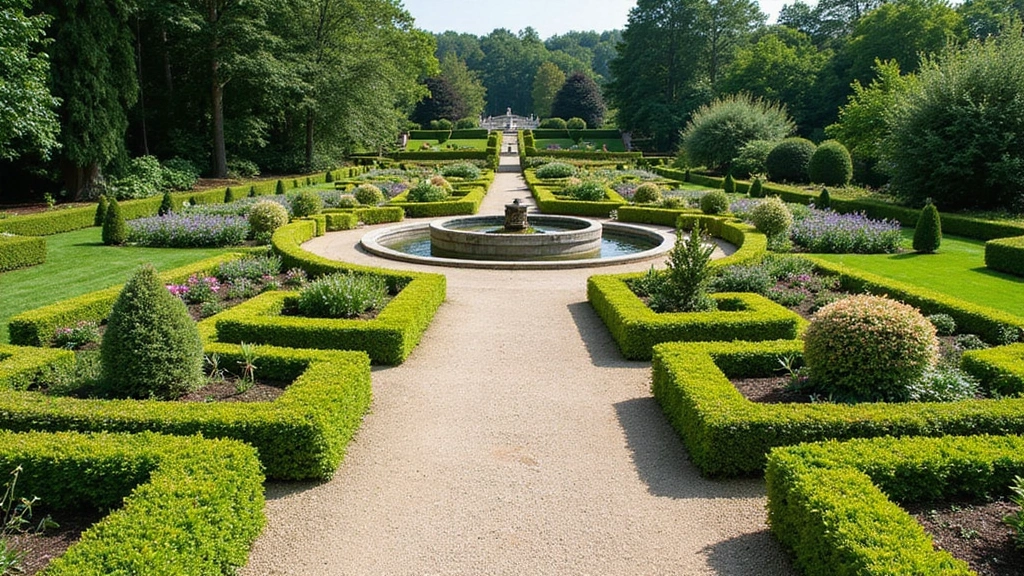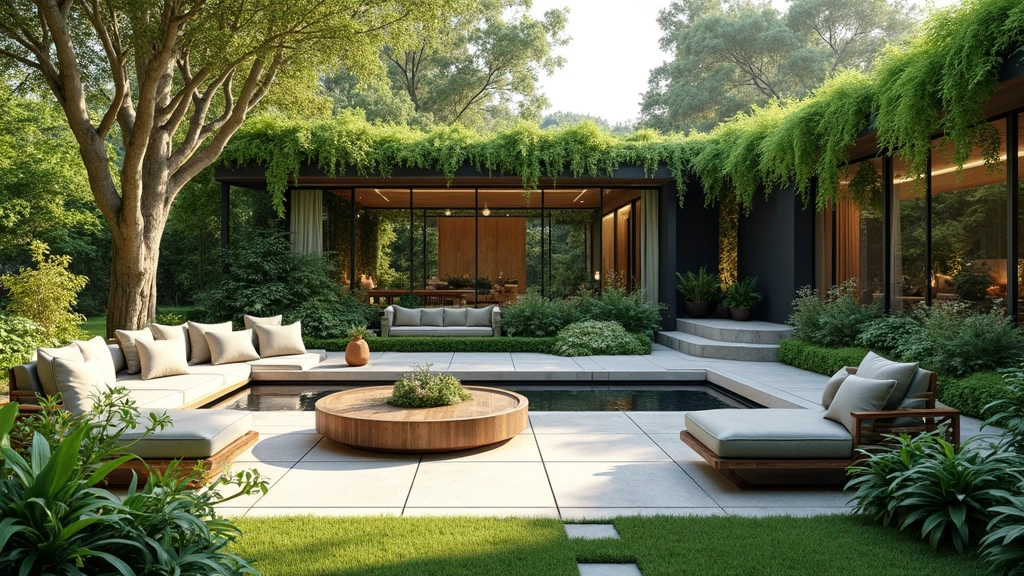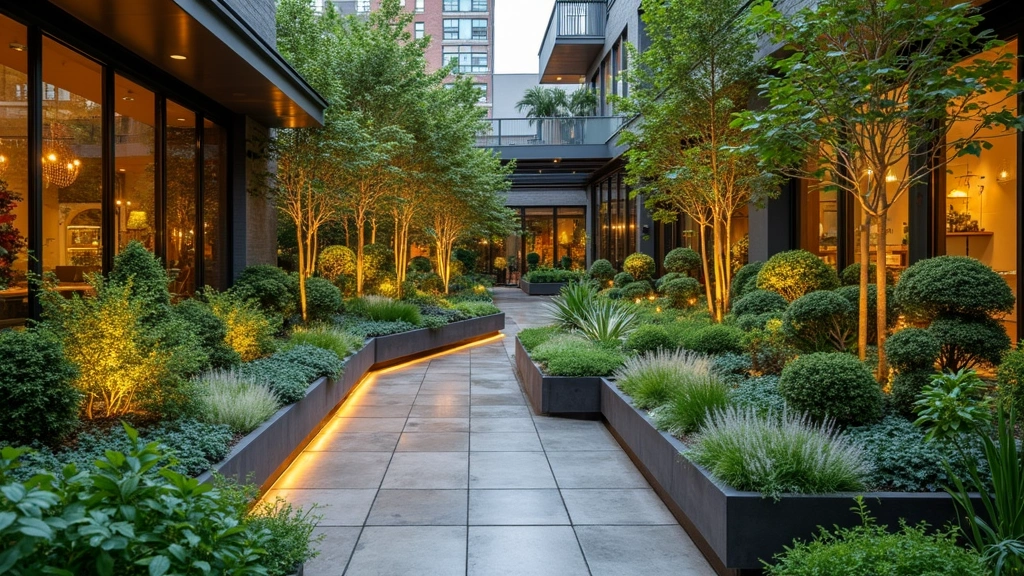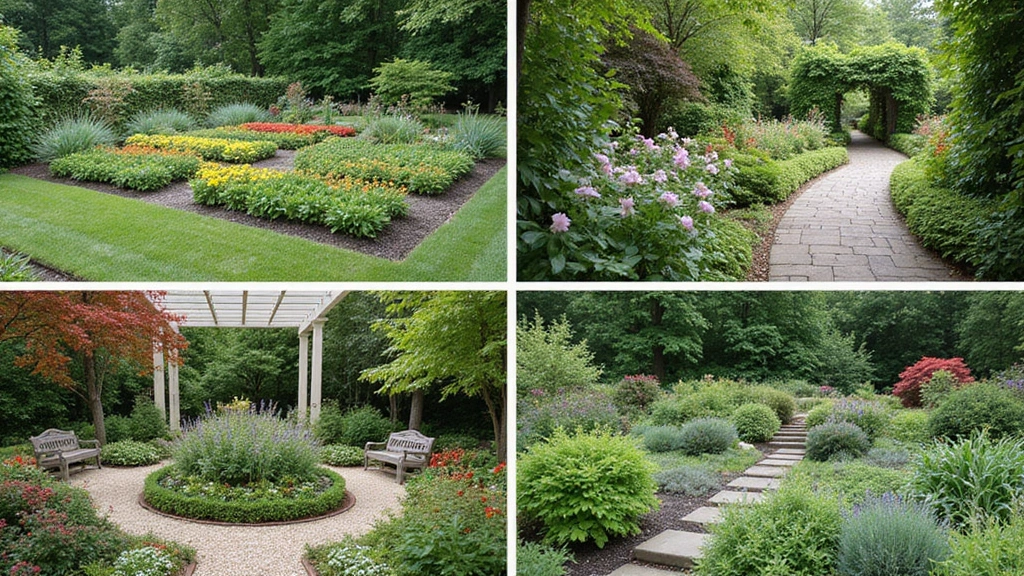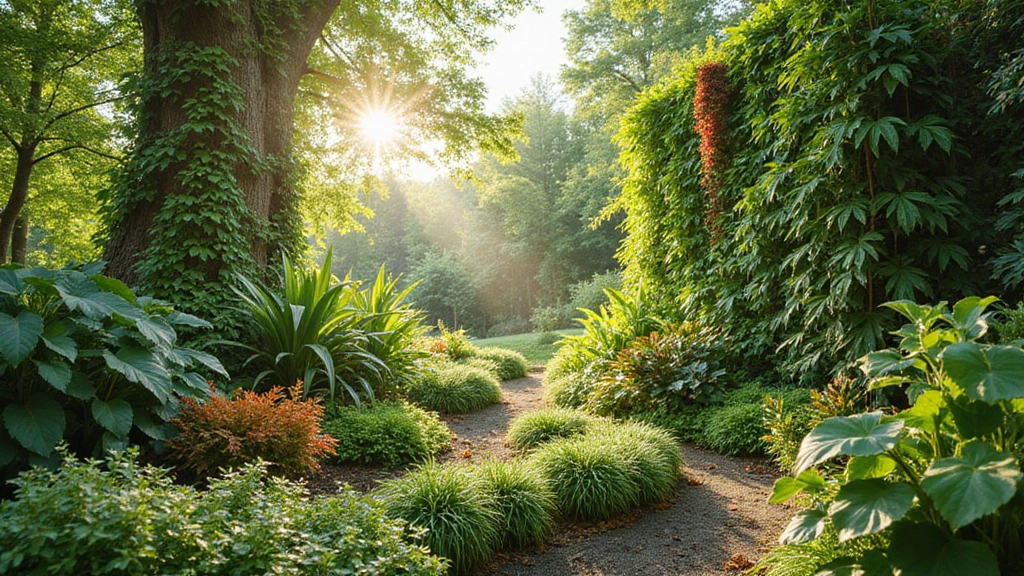Formal gardens are the epitome of elegance, blending structure and beauty in the great outdoors. This style emphasizes symmetry, geometric shapes, and a sense of order that can turn any backyard into a serene retreat. By incorporating native plants, these gardens not only enhance aesthetics but also support local ecosystems, creating a win-win for nature lovers. Whether you have a sprawling estate or a cozy courtyard, these principles can elevate your gardening game and align with eco-friendly practices.
Let’s explore 25 essential design principles to help you craft a formal garden that shines with elegance and charm.
1. Embrace Symmetry
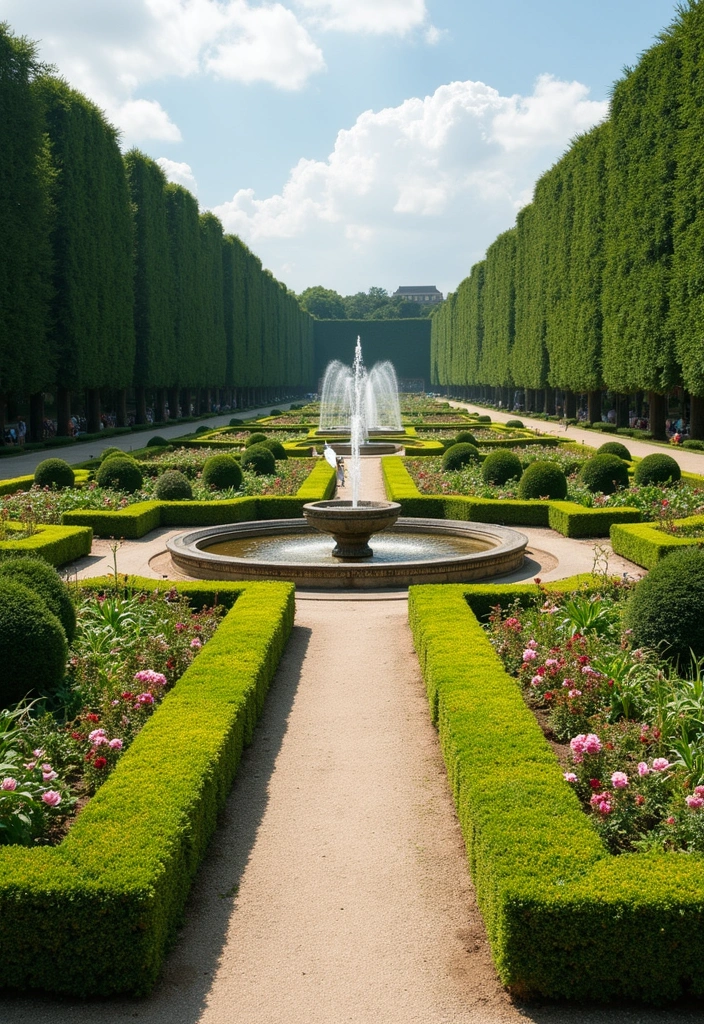
Symmetry is the backbone of formal garden design. This principle helps create a balanced and harmonious look that pleases the eye. Start by designing pathways or borders that mirror each other across a central axis. For instance, imagine two identical flowerbeds on either side of a grand walkway, inviting visitors to stroll through.
To achieve this symmetrical effect, consider using identical flower planters that can be placed in matching locations on either side of your pathways. These planters not only provide a cohesive aesthetic but also enhance the visual appeal of your garden.
You can also incorporate garden pathway edging to define the lines of your walkways clearly, helping to maintain that structured feel essential to formal gardens. This edging is flexible and easy to install, ensuring that your paths look neat and orderly.
Additionally, consider adding focal points like garden sculptures that can be reflected across the garden. These stylistic elements will not only draw the eye but also create a sense of continuity and balance.
By embracing symmetry and utilizing these products, you establish order and elegance in your outdoor space.
2. Geometric Shapes
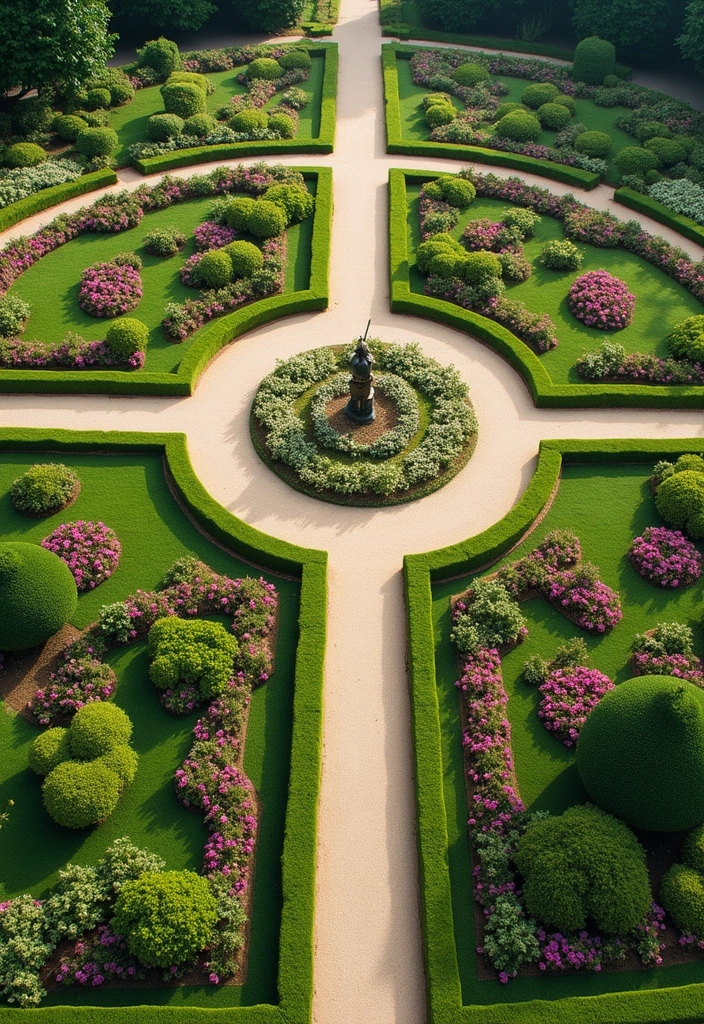
Geometric shapes add a sense of structure and refinement to any formal garden. Think squares, rectangles, and circles; these shapes can be applied to garden beds, pathways, and even shrub arrangements. Using geometric patterns guides the eye and creates a flow within the space.
Ideas for incorporating geometry:
– Design raised garden beds in rectangular shapes for a modern look. Consider using the Land Guard galvanized raised garden bed kit, which offers a sturdy and stylish solution for planting vegetables.
– Circular flower gardens can serve as charming focal points. A great option for this is the JERIA raised garden bed. Its round design makes it perfect for showcasing flowers, creating an inviting centerpiece in your garden.
– Create pathways that form geometric designs, enhancing visual interest. The EasyFlex no-dig landscape edging can help define these pathways beautifully, offering a decorative stone-look while keeping your garden edges neat.
Utilizing geometric shapes not only looks tidy but also helps define different areas within your garden, adding to its overall elegance. These products can help you achieve a structured and visually appealing outdoor space.
3. Create Focal Points
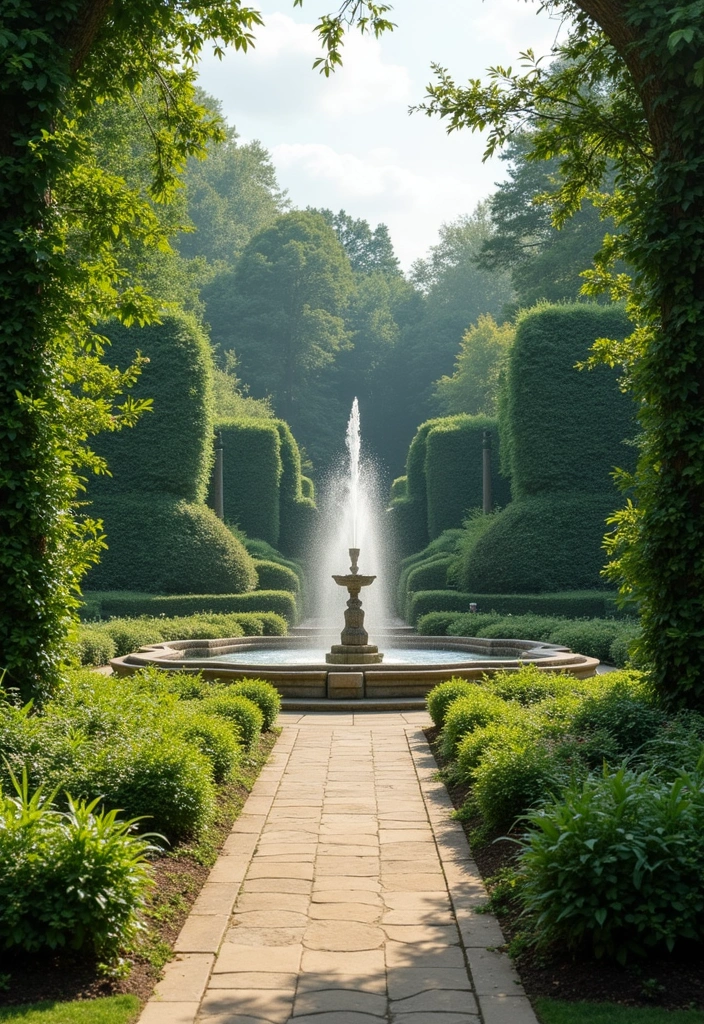
A focal point draws the eye and creates an anchor within the garden design. This can be anything from a stunning sculpture, a fountain, or a unique tree. By strategically placing these elements, you can create a sense of intrigue and beauty.
How to choose a focal point:
– Look for unique features that can stand out, like a colorful native plant or a classic statue. For instance, the Lakeside Collection heart garden sculpture makes an eye-catching addition with its charming design, perfect for drawing attention without overwhelming the space.
– Ensure it’s easily visible from various angles in the garden. A well-placed outdoor fountain not only serves as a stunning centerpiece but also adds a soothing sound of flowing water, enhancing the garden’s atmosphere from multiple viewpoints.
– Keep the surrounding design simple to highlight the focal point. Consider incorporating a Kwanzan cherry blossom tree. This unique tree or plant, with its lovely pink blooms, can serve as a vibrant accent that stands out beautifully against simpler landscaping.
Focal points elevate your garden’s appearance while providing a stunning centerpiece that invites admiration.
4. Use Pathways Wisely
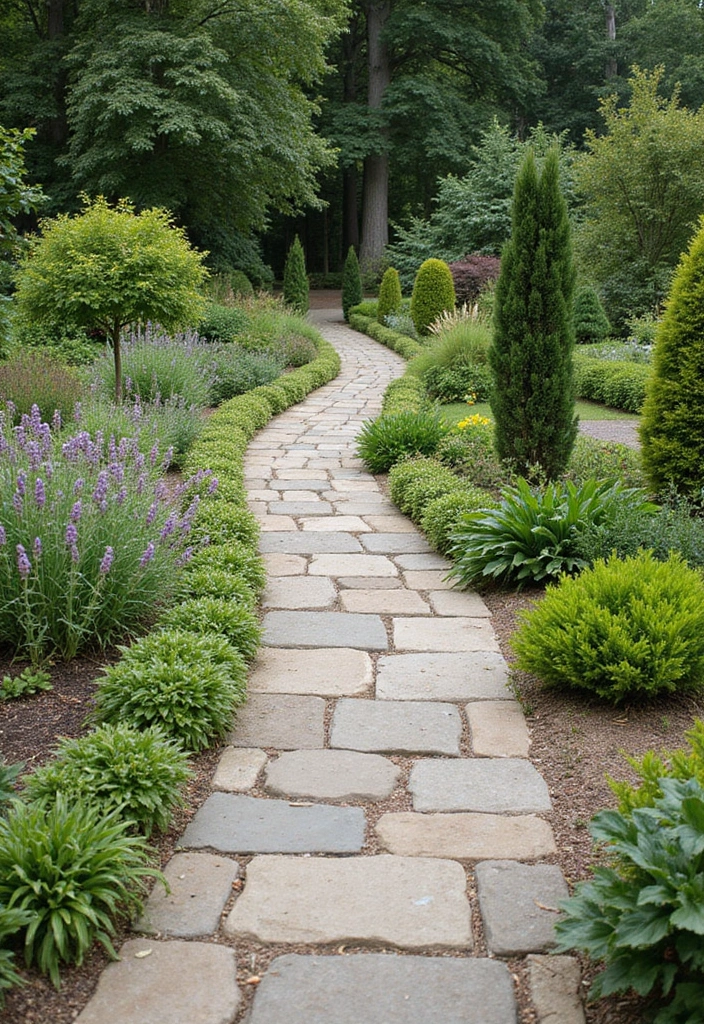
Pathways guide visitors through your formal garden while adding functionality and charm. The design of these paths should complement the garden layout and be made from materials that harmonize with the natural surroundings. Consider using natural stone pavers for a classic look that integrates seamlessly into the landscape. Whether it’s a gravel path, stone tiles, or paved walkways, pathways are crucial in defining movement within the garden.
Pathway design tips:
– Avoid straight lines; gently curved paths can create a more inviting appearance. Using gravel pathway material can help achieve this, as gravel naturally settles into curved shapes, enhancing the aesthetic of your garden.
– Use materials that match the garden’s character, like reclaimed wood garden edging to define flower beds and borders, adding a rustic charm that complements a formal setting.
– Consider accessibility with wider paths for easy navigation, ensuring that all visitors can enjoy the beauty of your garden without difficulty.
Well-designed pathways enhance the overall experience and elegance of your formal garden.
5. Layering Plants
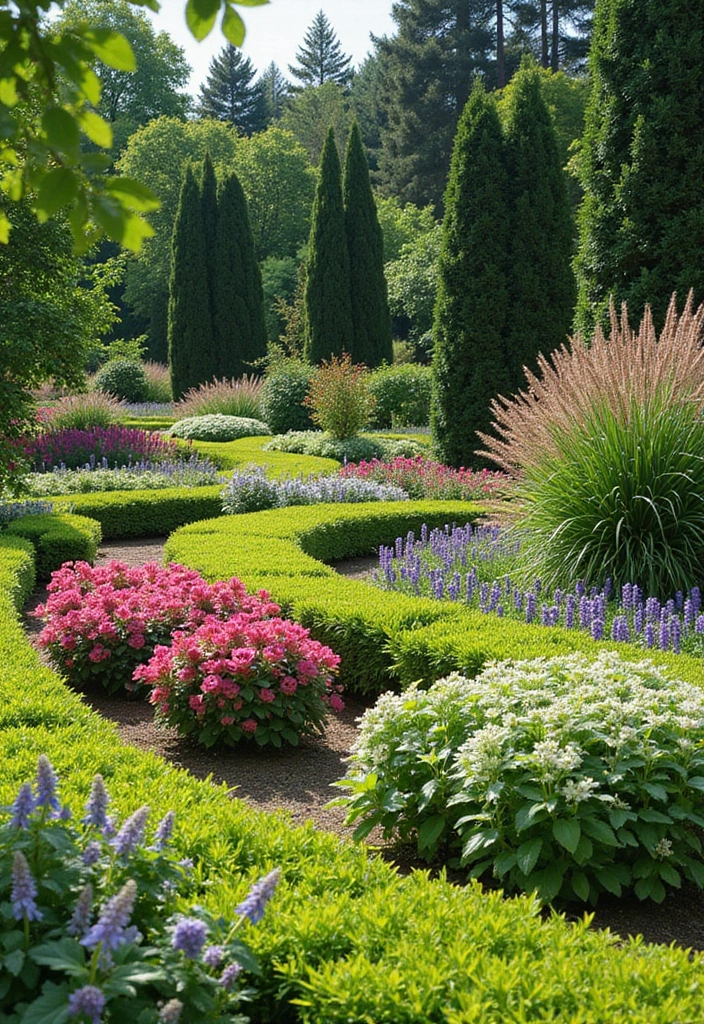
Layering plants involves arranging them in a way that creates depth and visual interest. In a formal garden, this can mean placing taller plants at the back and shorter ones in front, ensuring every plant gets the attention it deserves. This technique not only enhances the aesthetic appeal but also contributes to a lush, full look that feels inviting.
To successfully implement layering, consider using a mix of native plants to ensure hardy blooms all season long. A great resource for this is the Garden Planting Guide Book, which provides valuable insights on how to grow plants in various settings, including raised beds and vertical gardens.
Additionally, it’s essential to think about seasonal changes; selecting plants that will peak at different times can keep your garden vibrant year-round. When planting, use tools that make the process easier, such as a garden trowel set. This heavy-duty gardening tools set includes a shovel, transplant trowel, and hand rake, all designed with ergonomic, non-slip handles for comfortable use.
Finally, pay attention to color and texture variety to keep the eye engaged. To ensure the health of your plants and maintain their visual appeal, using a soil moisture meter can be incredibly helpful. This device allows you to monitor the moisture levels in the soil, ensuring that each layer of plants receives the right amount of water, which is crucial for their growth and overall health.
Layering plants not only looks beautiful but also helps maintain the health of your garden by providing adequate sunlight and air circulation for all varieties, creating an inviting outdoor space.
6. Consider Seasonality
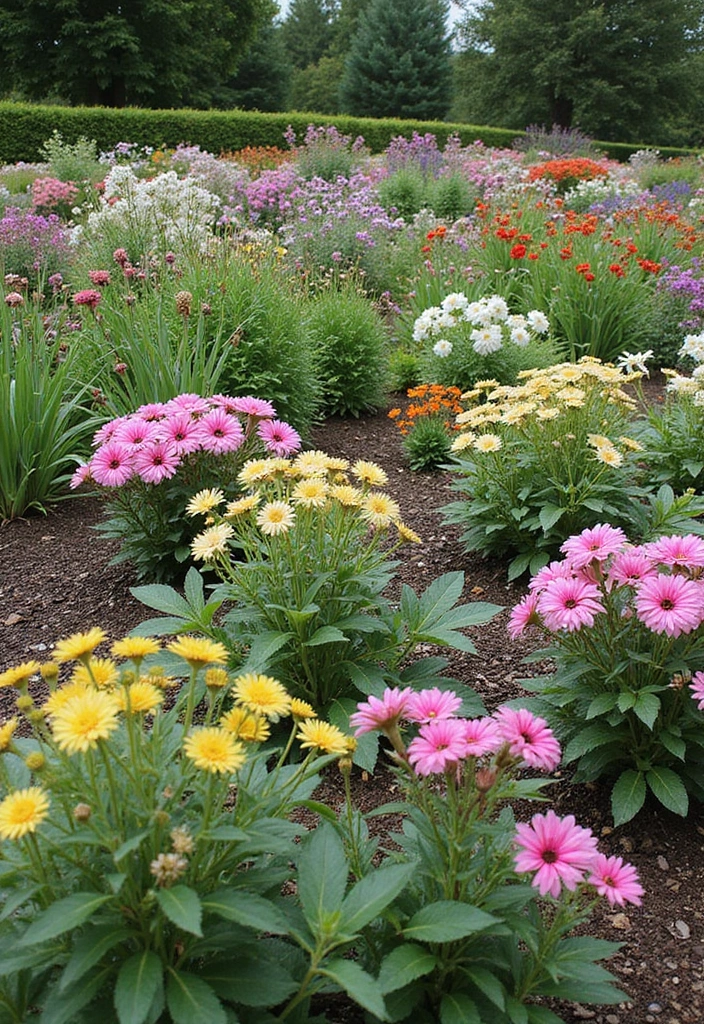
A well-designed formal garden is a year-round showstopper, which means you should consider seasonality in your plant selection. Choosing native plants that bloom in different seasons helps maintain color and interest throughout the year, ensuring that your garden is not just beautiful in spring but also holds its charm in summer, fall, and winter.
To kick off the spring, consider planting early bloomers like crocuses or daffodils from the seasonal flower bulbs collection. With 50 fresh bulbs designed to bloom all spring and summer, this collection makes it easy to infuse your garden with vibrant life after the winter chill.
For the summer months, opt for perennials such as coneflowers that deliver stunning hues. A great addition for fall is the perennial plant assortment, featuring beautiful flowering asters in shades of purple. This 12” tall plant will ensure your garden remains captivating as the foliage begins to change.
As the seasons shift, incorporating ornamental grasses can provide stunning visuals, particularly in fall. Check out the ornamental grasses variety pack to offer diverse textures and colors that will keep your landscape intriguing even as the leaves fade.
By paying attention to seasonality, your garden can constantly evolve, keeping it fresh and appealing no matter the month.
7. Establish Clear Boundaries
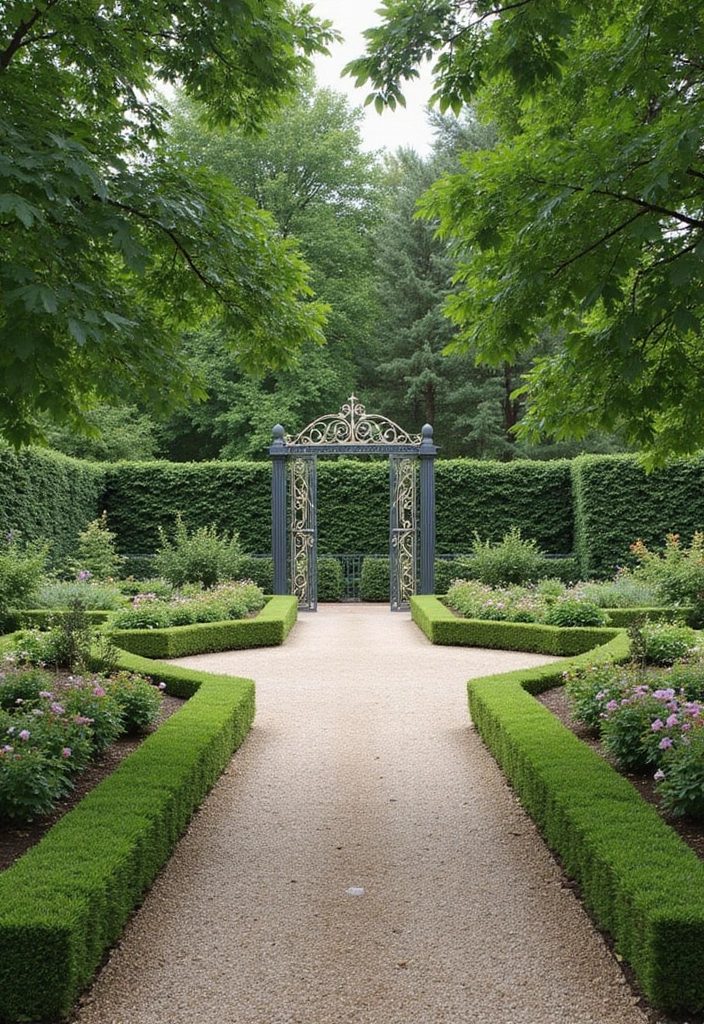
In a formal garden, clearly defined boundaries help maintain structure and organization. This can be achieved through hedges, fencing, or even decorative pots. Boundaries serve to separate different areas, guiding visitors through various sections while enhancing the garden’s aesthetic appeal.
A great option for creating attractive borders is using hedges as natural dividers that grow tall while maintaining a neat appearance. If you’re looking for something with a bit more character, consider adding decorative garden fencing. This rustproof metal no-dig fence is perfect for creating an ornamental border around flower beds or yard areas, providing both structure and visual charm.
To enhance pathway edges while keeping your garden tidy, you might also want to explore stone garden edging. This easy-to-install solution looks like natural stone and helps establish a clean separation between garden beds and walkways, adding to the overall elegance of your outdoor space.
By establishing clear boundaries, you create a sense of order, allowing each element in your garden to shine.
8. Incorporate Water Features
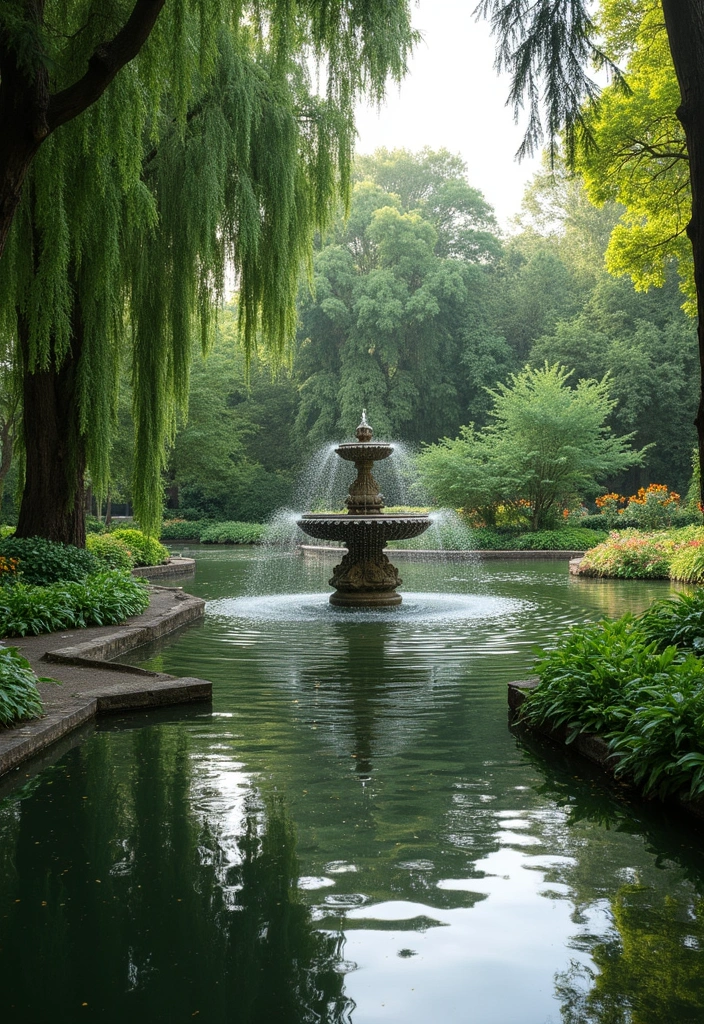
Water features, like fountains or ponds, can elevate the elegance of your formal garden while providing a soothing atmosphere. The sound of flowing water creates a peaceful ambiance, perfect for relaxation or meditative moments. These features also attract wildlife, adding vibrancy to your garden.
One great option is the Classic Garden Fountain, a rustic two-tiered barrel fountain that blends beautifully with various garden styles. Its relaxing water flow enhances the tranquil atmosphere you’re aiming for.
If you’re considering a more substantial feature, the Koi Pond Kit is an excellent choice. With a submersible pump and pond liner included, it allows you to create a stunning focal point that attracts local wildlife while offering a serene spot to unwind.
For a more subtle addition, the Birdbath with Stand provides an attractive and functional element to your garden. This vintage-style birdbath invites feathered friends, adding life and movement without overwhelming your garden’s design.
Incorporating these water features not only enhances beauty but also supports the local ecology, making your garden more eco-friendly.
9. Seasonal Color Schemes
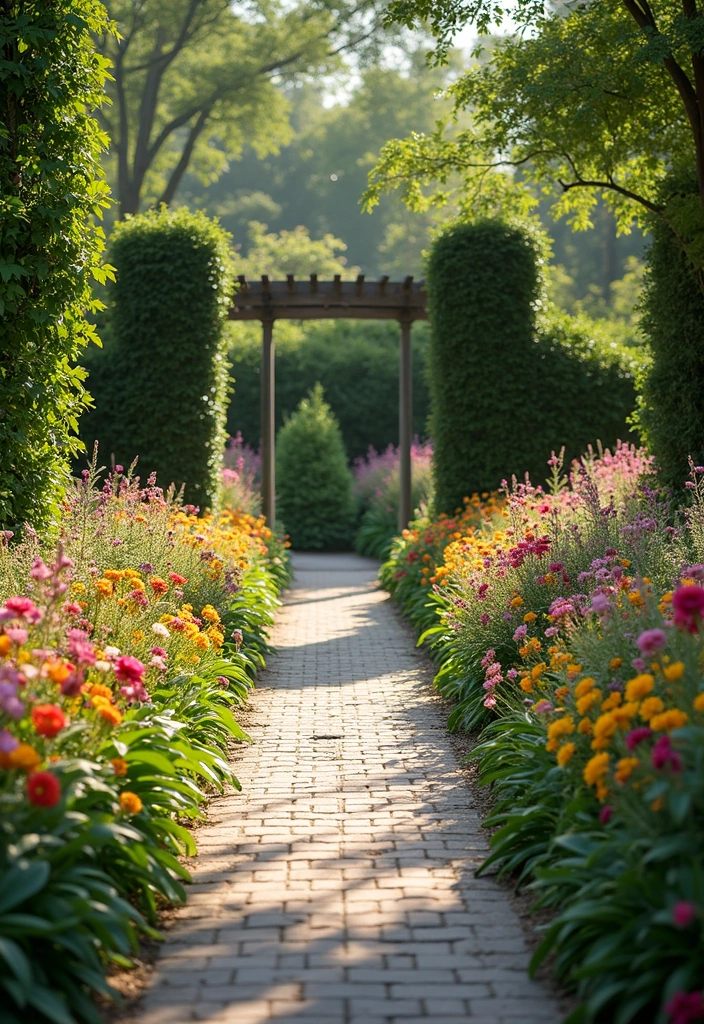
Choosing a cohesive color scheme is crucial in formal garden design. Seasonal color palettes create a harmonious look while ensuring visual interest throughout the year. By selecting native plants that complement each other, you can produce a stunning display of colors. To assist you in this endeavor, consider using a garden color wheel, which can help you create exciting color combinations that enhance your garden’s appeal.
Color scheme tips:
– Opt for a limited palette for a more elegant and sophisticated feel.
– Incorporate a mix of colors that bloom at different times to keep the garden lively.
– Consider foliage colors as well; evergreen plants can add depth in winter. A evergreen plant selection kit can provide you with a variety of options to ensure your garden remains vibrant even in the colder months.
A well-planned color scheme enhances the beauty of your formal garden, making it a constantly evolving masterpiece. For additional guidance, the native plant guidebook offers insights into plants that thrive in your local environment, ensuring that your selections are both beautiful and sustainable.
A well-planned seasonal color scheme is like poetry for your formal garden; it brings elegance and harmony with every bloom. Choose native plants to create a vibrant masterpiece that changes with the seasons!
10. Incorporate Edible Plants
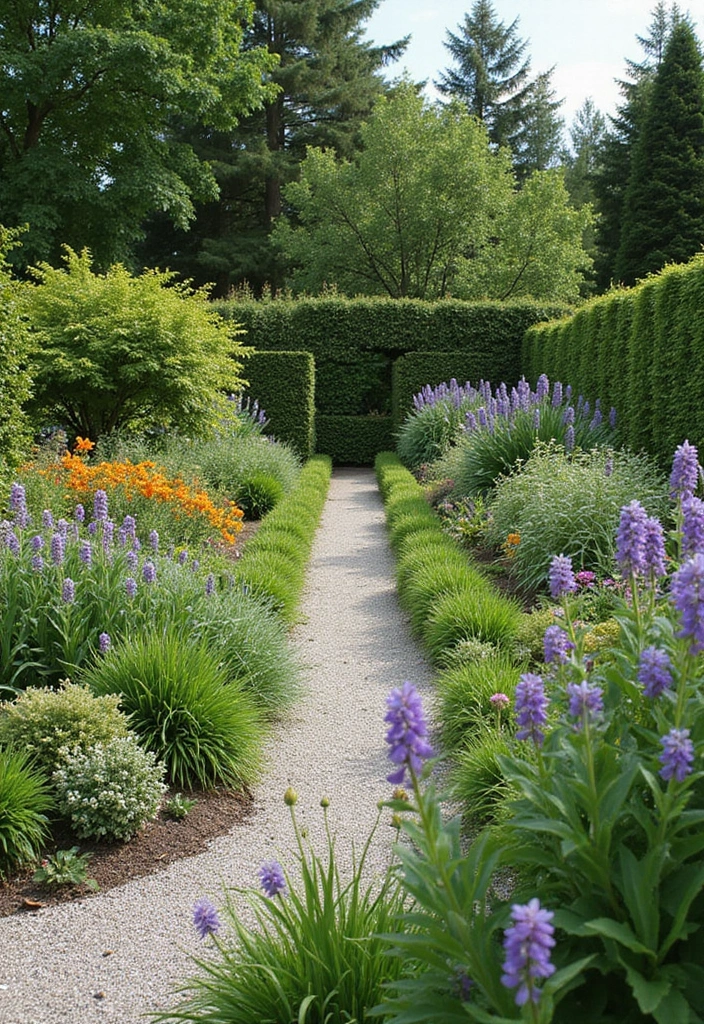
Formal gardens can be both beautiful and functional by incorporating edible plants. Using native and local varieties of fruits, vegetables, and herbs can add a unique touch to your garden while providing fresh produce. This approach not only enhances aesthetics but also promotes sustainability.
Ideas for edible plants in your formal garden:
– Use ornamental kale seeds to create unique textural interest. These plants add a visually striking element while being entirely edible.
– Grow a variety of berry bushes, such as raspberry or blueberry, along pathways for easy access and visual appeal. They not only provide delicious fruit but also contribute beauty with their colorful foliage and blossoms.
– Incorporate an herb garden starter kit that includes kitchen herbs like lavender or rosemary. These herbs can serve as fragrant borders while boosting your culinary creations.
By blending beauty with utility, you create an eco-friendly garden that delights the senses and nourishes the body.
You might also like
11. Use Native Plants

Utilizing native plants is essential in formal garden design, especially for an eco-friendly approach. Native plants are adapted to your local climate and soil conditions, making them easier to maintain and more resilient than non-natives. They also support local wildlife by providing habitat and food sources.
To help you get started, consider using a Native Plant Guidebook. This resource can assist you in selecting the right plants that thrive in your area, ensuring your garden is both beautiful and sustainable.
Benefits of native plants:
– Require less water and fertilizer, promoting sustainability. For instance, you can enhance your garden’s health with Organic Fertilizer for Native Plants. This fast-acting water-soluble plant food is specifically formulated to meet the needs of a variety of plants, including those that are native to your region.
– Attract beneficial insects and pollinators, enhancing the garden’s ecosystem. To encourage a thriving pollinator population, consider planting pollinator-friendly plant seeds. This mix includes 18 varieties of non-GMO flower seeds that can significantly boost the attractiveness of your garden for essential pollinators.
– Often have unique beauty that reflects local character.
By focusing on native plants, you create a garden that’s not only stunning but also respectful of the environment.
12. Accessibility and Flow
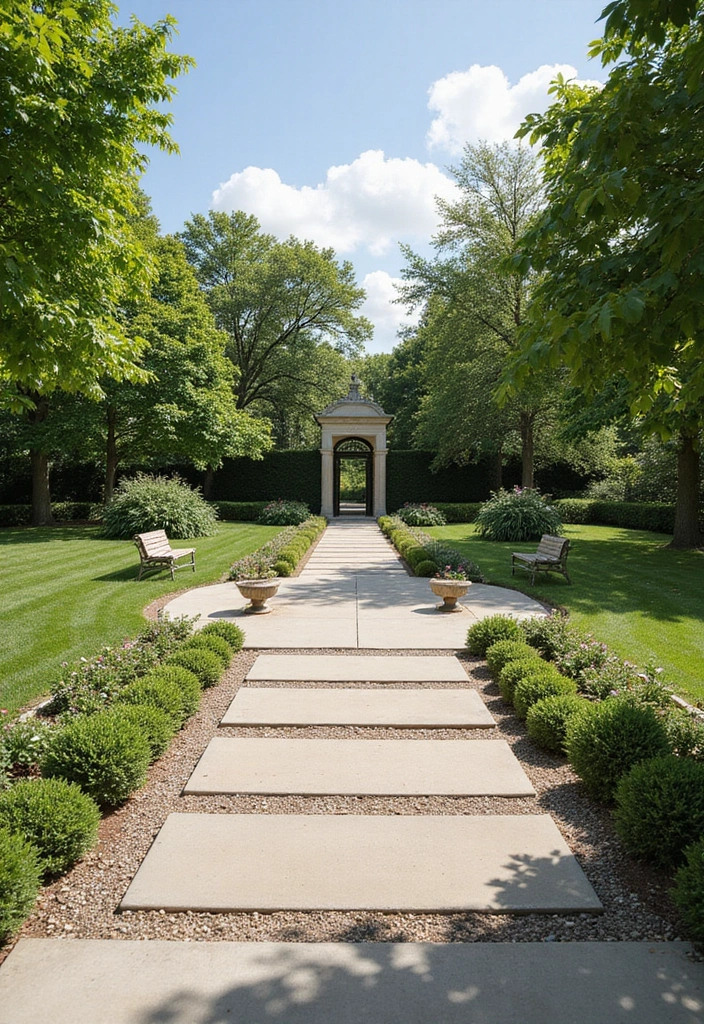
Ensuring that your formal garden is accessible for everyone is a key design principle. This means considering pathway widths, seating arrangements, and plant heights. Creating a smooth flow through the garden invites visitors to explore and enjoy the space fully.
To enhance accessibility, consider using garden pathway pavers, which are designed to be wide enough for wheelchairs or strollers. These pavers create a stable, non-slip surface that guides visitors through your outdoor space, making it easier for everyone to navigate.
Additionally, incorporating an outdoor garden bench can provide strategic resting points along the paths. This weatherproof, heavy-duty bench not only offers a comfortable place to sit but also enhances the overall aesthetics of your garden, encouraging guests to linger and appreciate the surroundings.
Moreover, by avoiding tall plants that could obstruct views or pathways, you promote a more open and inviting environment. By prioritizing accessibility with thoughtful products and design choices, you create a welcoming space that everyone can enjoy.
13. Invite Wildlife
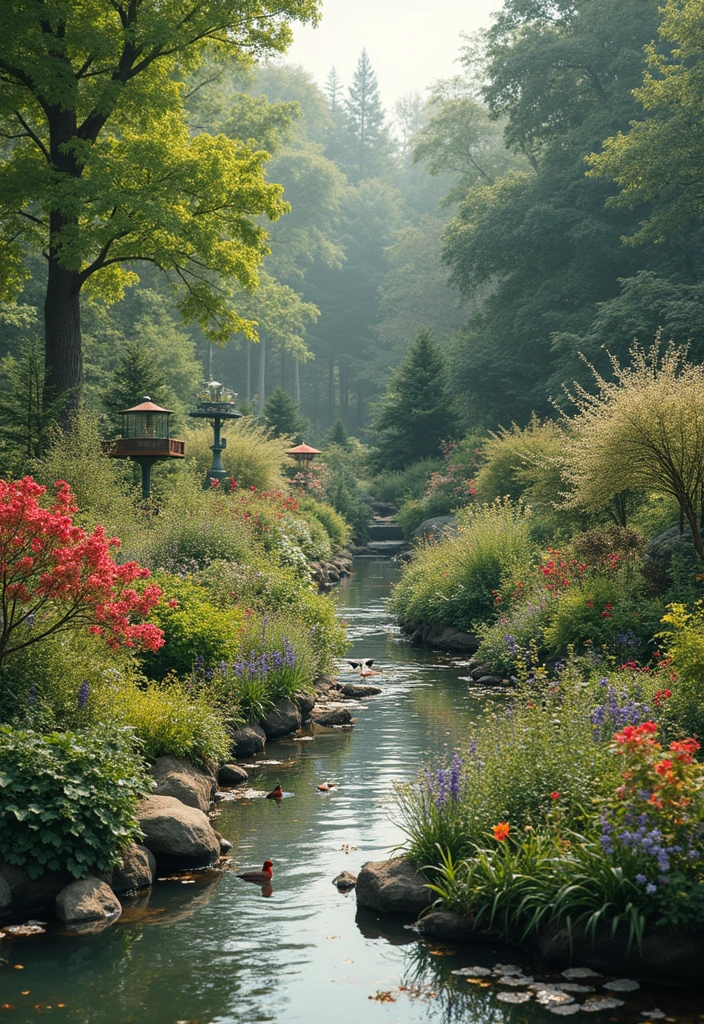
Creating a formal garden that invites wildlife can enhance its beauty while also supporting biodiversity. By incorporating native plants, water features, and food sources, you can attract birds, butterflies, and beneficial insects, enriching your garden’s ecosystem.
To encourage wildlife in your garden, consider installing bird feeders in open areas for easy viewing, such as the Wagner’s 53002 Farmer’s Delight Wild Bird Food with Cherry Flavor. This bird food will attract a variety of feathered friends with its delicious cherry flavor, offering a lovely sight while supporting healthy bird populations.
Using plants that produce nectar or berries is essential to attract pollinators. For this purpose, you might want to add native plants like Survival Garden Seeds Blue Vervain Seeds to your garden. These seeds grow into beautiful wildflowers that are not only visually appealing but also act as a butterfly magnet, making your garden a vibrant haven for these essential pollinators.
Additionally, creating sheltering spots with native shrubs or flowers can provide vital habitats for wildlife. You might also consider adding a delightful water element with the Aquascape AquaGarden Container Water Feature Kit. This mini pond with a waterfall fountain can enhance the beauty of your garden while attracting birds and beneficial insects looking for water.
Encouraging wildlife adds dynamic elements to your garden while fostering an eco-friendly environment.
14. Opt for Perennials
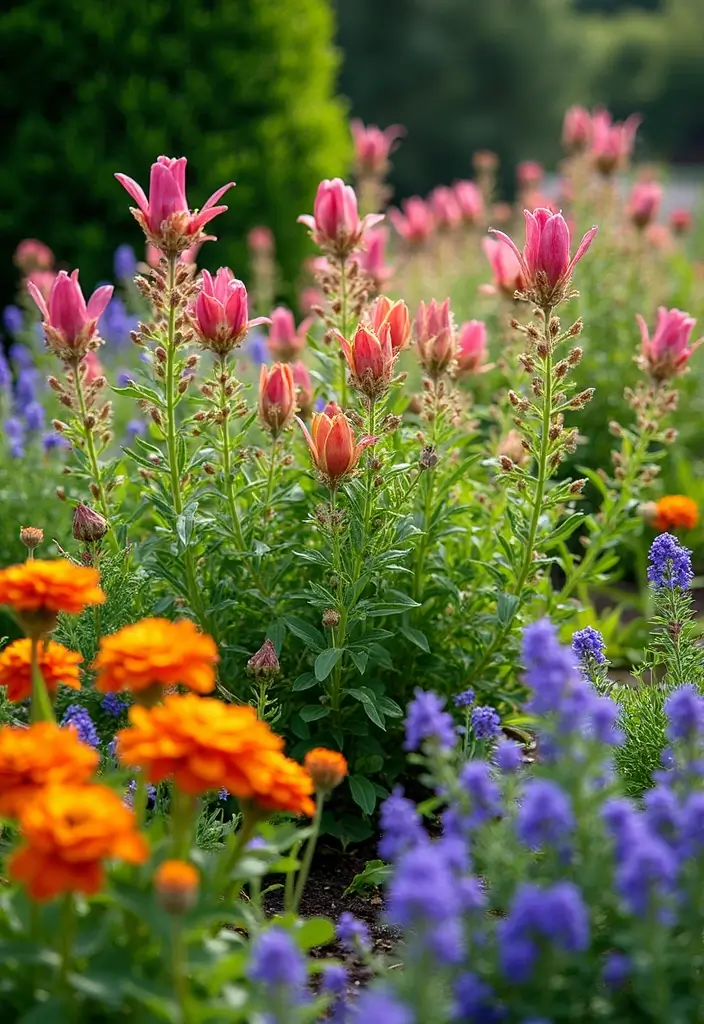
Perennials are a fantastic addition to any formal garden due to their reliability and beauty over the seasons. These plants return year after year, providing consistent color and structure essential for a polished look. To ensure your garden thrives with minimal maintenance, consider choosing native perennials.
For stunning summer blooms, Echinacea seeds are a wonderful choice. They not only add vibrant colors to your garden but are also known for their resilience.
If you’re looking for vibrant colors and easy care, the daylily plants from the Southern Living Plant Collection are perfect. These hardy plants can brighten up your garden with their variety of hues and require minimal attention, making them a favorite among gardeners.
For unique textures and drought resistance, consider integrating sedum plants. These succulent plants are not only beautiful but also thrive in various conditions, adding a sustainable element to your garden design.
Integrating a wide array of perennials like these can create a vibrant, sustainable garden that looks great through every season.
15. Create Outdoor Rooms
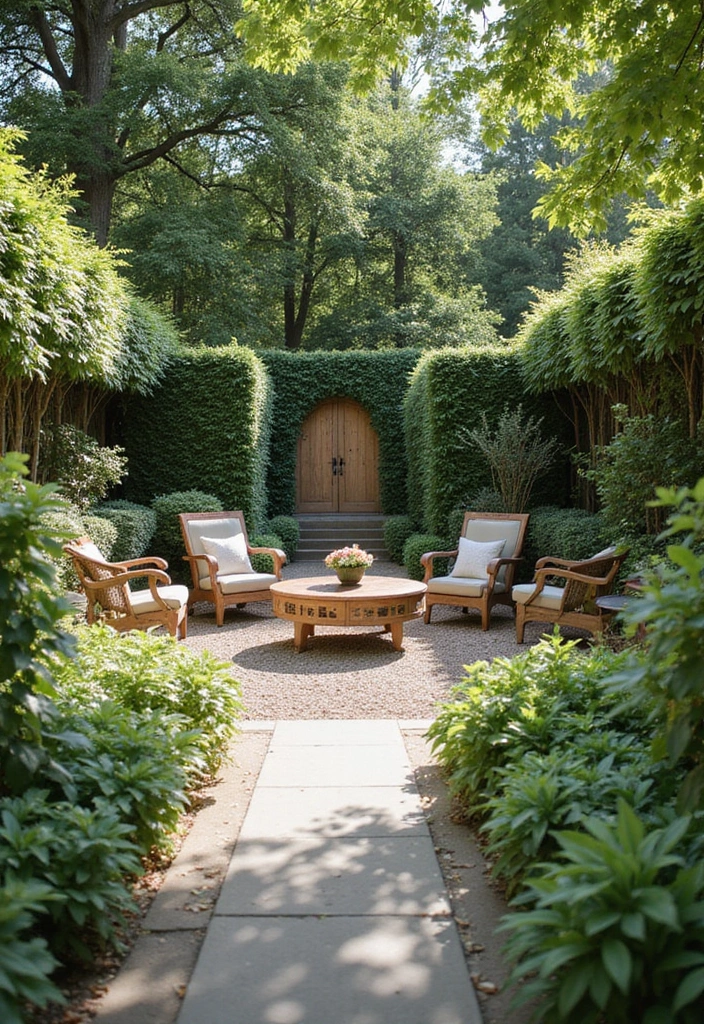
Transforming parts of your garden into outdoor ‘rooms’ can enhance the sense of space and provide areas for relaxation and entertainment. You can define these rooms through thoughtful plantings, pathways, and seating arrangements, creating various experiences within your formal garden while maintaining a cozy feel.
To create inviting seating areas, consider the outdoor garden seating set. This modern rattan chairs conversation set comes with a weather-resistant coffee table, making it perfect for enjoying the garden atmosphere surrounded by fragrant herbs and flowers.
For added privacy and structure, using trellises can make a significant difference. The trellis for climbing plants offers a stylish way to support native plants that can create a beautiful green wall while enhancing your outdoor ‘rooms’.
Incorporating dedicated outdoor dining spaces can further encourage enjoyment of your garden. The outdoor dining table and chairs set provides ample seating for gatherings, complete with an umbrella hole for sunny days, allowing you to savor meals while immersed in nature.
Creating these outdoor rooms invites relaxation and interaction, making your formal garden feel like a true extension of your home.
16. Mind the Sunlight

Understanding sunlight patterns is essential when designing your formal garden. Some plants thrive in full sun, while others prefer shade. By observing your garden throughout different times of the day, you can strategically place plants according to their sunlight needs, ensuring they flourish.
To help you track sunlight patterns and categorize your garden into sunny and shady areas, consider using the Garden Sunlight Tracker. This tool allows you to monitor sunlight exposure and make informed decisions about plant placement.
Choosing plants based on their sunlight preferences is crucial to avoid stress and maintain health. For additional guidance on selecting suitable plants, the Planting Guide for Sunlight Preferences can be a valuable resource, providing insights into various species and their optimal growing conditions.
Additionally, consider incorporating shade-providing structures like the Adjustable Pergola into your garden design. This elegant addition not only offers comfort in sunny areas but also enhances the overall aesthetic of your space.
Mindful placement of plants according to sunlight can dramatically improve the health and vibrancy of your formal garden. With these tools and resources at your disposal, you can create a thriving outdoor environment.
17. Focus on Maintenance
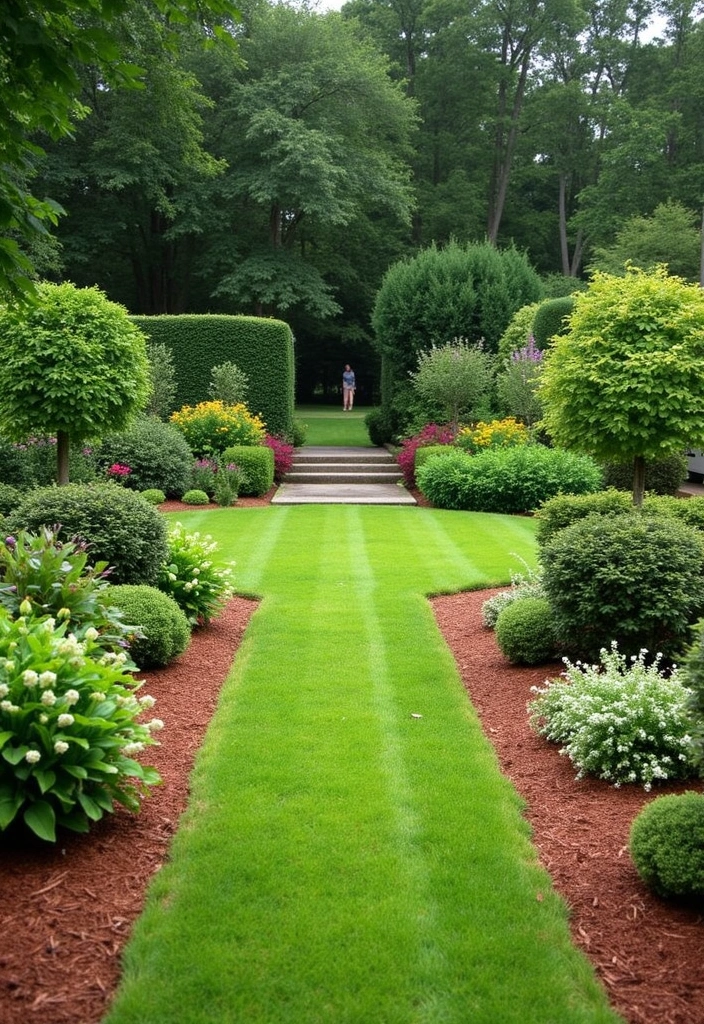
An often-overlooked aspect of formal garden design is maintenance. While creating an elegant garden is essential, it’s also crucial to design with upkeep in mind. Choose plants that are not only beautiful but also fit your ability to care for them.
To help you manage your garden more effectively, consider incorporating some helpful tools and techniques. For instance, grouping plants with similar water and sunlight needs together can make maintenance easier. A practical addition to your gardening toolkit is a watering can with measurement, which allows you to water your plants accurately and efficiently, ensuring they receive the right amount of hydration without the guesswork.
Using mulch is another effective strategy to reduce weeds and retain moisture in your garden. You might want to try garden mulch, which is made from all-natural wheat straw. This eco-friendly option not only conserves water but also helps in suppressing weeds, so you can spend less time on upkeep and more time enjoying your garden.
Additionally, planning a regular maintenance schedule can help keep everything thriving. To stay organized and ensure you don’t miss important tasks, a garden maintenance planner can be a valuable resource. It allows you to track your gardening activities and set reminders for watering, pruning, and other essential tasks.
By prioritizing maintenance and utilizing these helpful products, you can ensure your garden remains beautiful and manageable, allowing you to enjoy it without feeling overwhelmed.
18. Enhance with Sculpture
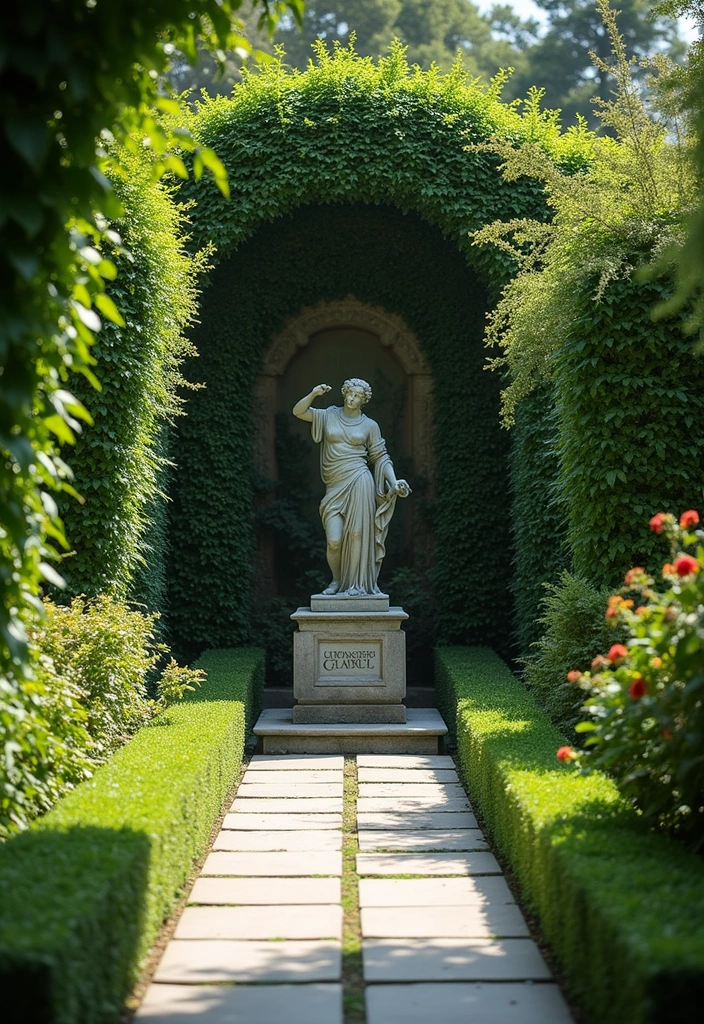
Sculpture can add an artistic flair to your formal garden, enhancing its elegance and sophistication. Different types of sculptures can tell a story or simply be appreciated for their beauty. Integrating art into your garden invites conversation and admiration while maintaining a formal feel.
When choosing sculptures, it’s important to select pieces that resonate with your garden’s theme and style. For example, the Lakeside Collection heart garden sculpture offers a charming and heartfelt addition that can create a warm focal point in your space. Positioning sculptures where they can be appreciated from various angles is essential, and the Alpine Corporation metal wide-eyed bird statue fits the bill perfectly, providing a whimsical touch that invites admiration from all sides.
Additionally, consider materials that complement the natural elements in your garden. The Ancient Graffiti stone garden statue brings a timeless quality to your outdoor space, harmonizing beautifully with plants and landscaping.
Adding sculptures not only beautifies but also adds a personal touch to your formal garden, making it uniquely yours. Artfully positioned sculptures can transform simple elegance into a captivating story, inviting both admiration and conversation. Choose wisely, and let your garden speak!
19. Seasonal Décor
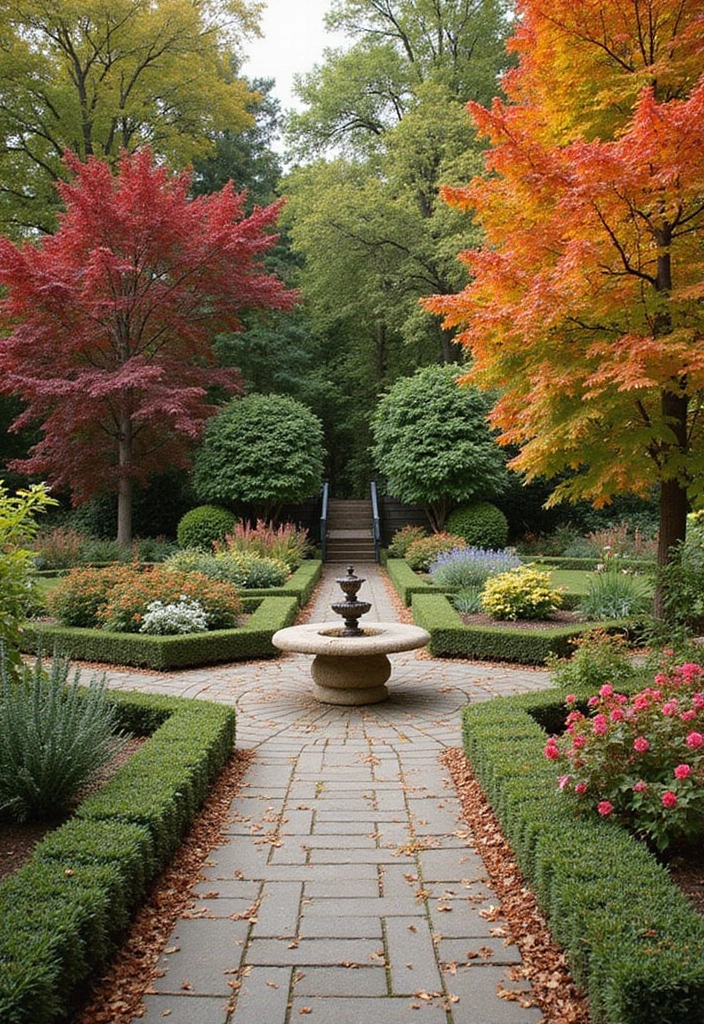
Switching up décor in your formal garden according to the season can keep the space feeling fresh and inviting. From seasonal flowers to decorative elements like lanterns or throws, small changes can make a big impact. This approach adds a layer of depth and keeps the garden exciting throughout the year.
Seasonal décor ideas:
– Use fall leaves or pumpkins for autumn charm.
– Bright flowers and soft textiles can enhance summer vibrance. For instance, consider adding seasonal flower seed kits which include a mix of perennial and annual wildflowers, perfect for adding a splash of color during warmer months.
– Incorporate evergreen branches and lights for a winter wonderland. Enhance the ambiance with seasonal decorative lanterns that provide a warm glow, creating a cozy atmosphere even on the coldest nights.
Don’t forget to introduce comfort with seasonal throw blankets, which are perfect for draping over outdoor seating, inviting you to enjoy the garden year-round. By embracing seasonal décor, you create a dynamic garden that feels alive and engaging, regardless of the time of year.
20. Incorporate Seating Areas
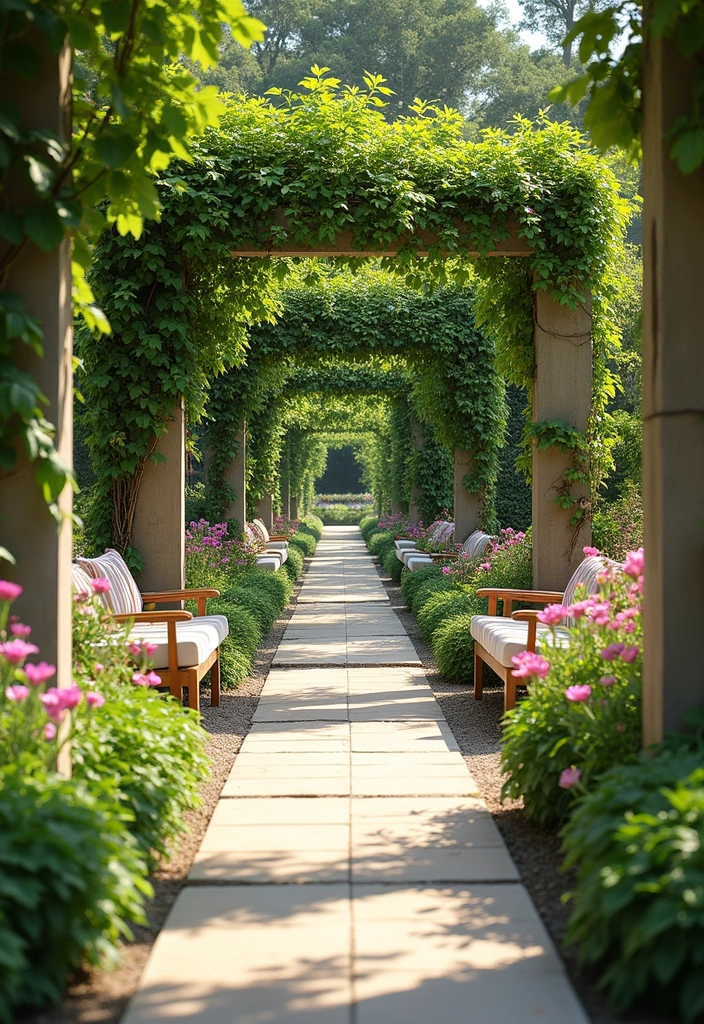
Seating areas in a formal garden invite people to linger and enjoy the beauty surrounding them. Whether it’s a simple bench like the weather-resistant garden bench, a stylish chair set such as the outdoor lounge chair set, or a cozy nook, these spaces encourage relaxation and connection with nature. They serve as perfect spots for reading, meditation, or simply soaking up the sun.
When designing your seating areas, consider positioning them near focal points for the best views. Choosing comfortable furniture made from weather-resistant materials, like the aforementioned bench and lounge chairs, ensures longevity and enhances your outdoor experience. To add extra comfort and a pop of color, incorporate decorative elements such as the decorative outdoor cushions, which are not only waterproof but also feature handles and ties for easy use.
Incorporating these seating ideas transforms your garden into a welcoming retreat, making it a space people love to return to.
21. Use Lighting Effectively
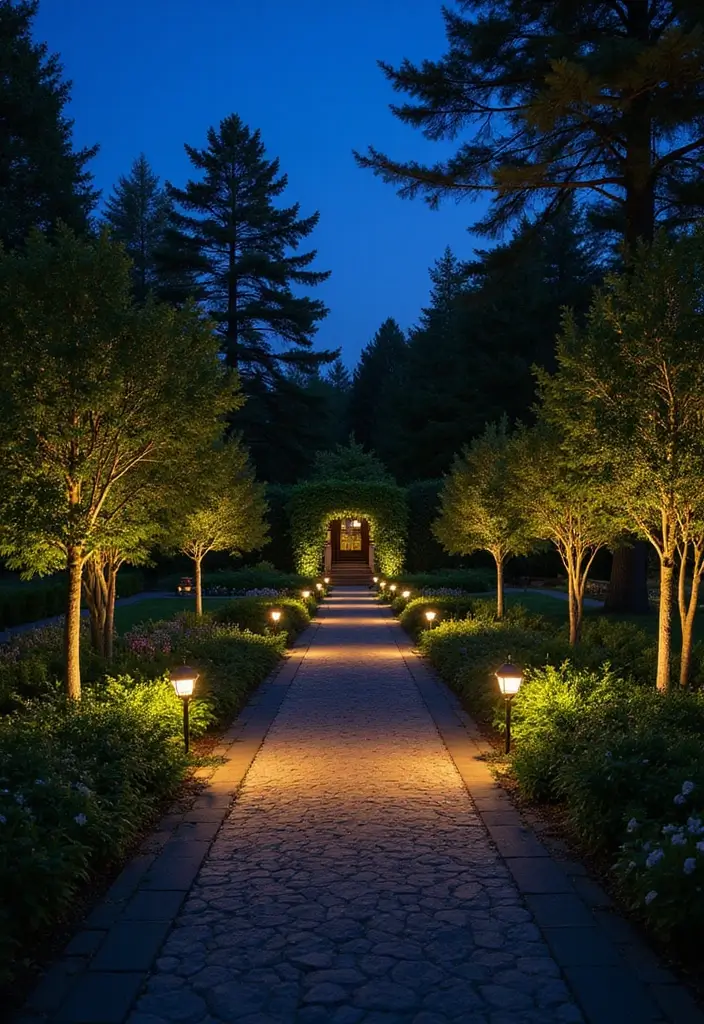
Effective lighting can transform your formal garden from day to night, creating a magical ambiance. Strategic placement of lights can highlight paths, focal points, and unique plantings, enhancing beauty after sunset. For instance, NYMPHY solar lights outdoor waterproof are an excellent choice, offering warm white illumination that adds a soft touch to your landscape while being eco-friendly. Additionally, you might consider the solar spot lights outdoor, which effectively spotlight key features like sculptures or water elements with their adaptable lighting modes.
Moreover, for a charming and vintage feel, Brightever LED outdoor string lights provide 100 feet of beautiful illumination, perfect for draping across patios or garden areas.
The right lighting ensures that your garden remains enchanting even after the sun goes down, creating a truly captivating outdoor experience while also enhancing safety and elegance in your design.
22. Pay Attention to Texture
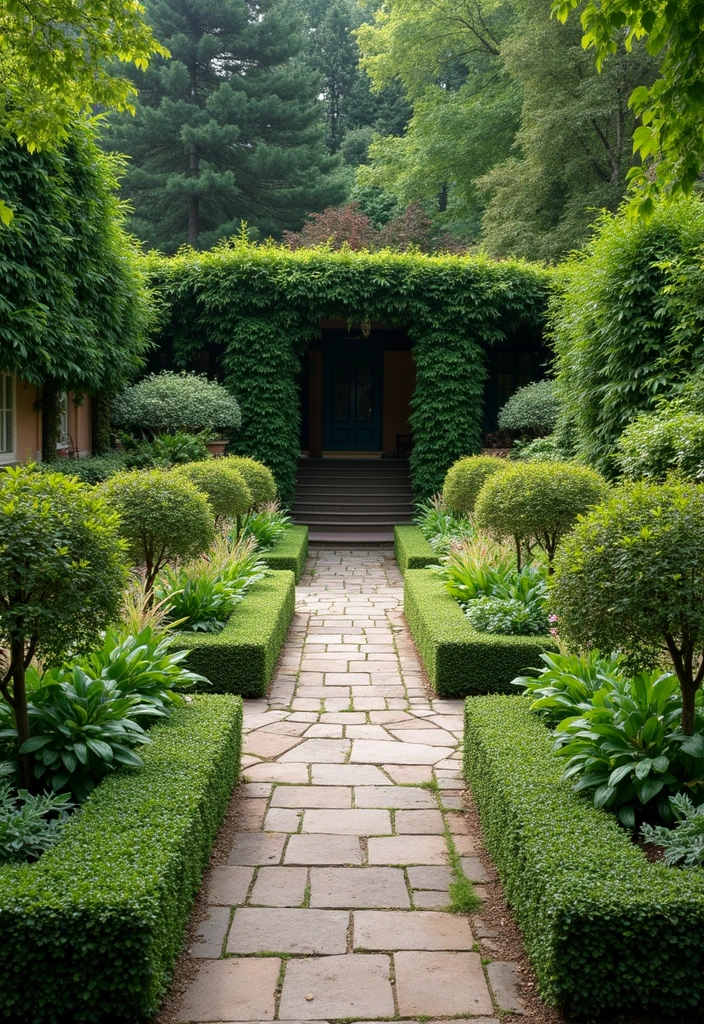
Texture adds another dimension to garden design, making spaces feel rich and interesting. By combining plants with different leaf shapes, bark textures, and flower forms, you can create a layered look that keeps the eye engaged and elevates the overall elegance of your formal garden. For example, incorporating Calamagrostis a. ‘Karl Foerster’ (Feather Reed) ornamental grasses from the Ornamental Grasses Variety Pack introduces smooth, graceful foliage that provides contrast to spiky or fuzzy plants.
Additionally, consider hardscape elements like decorative stone-look garden borders. The EasyFlex no-dig landscape edging offers a stylish way to add texture and structure to your garden while creating a clear separation between flower beds and paths.
To enhance visual interest even further, include various leaf shapes with decorative elements. The Mixed Leaves Mulberry Paper Leaves collection can be a charming addition to your decor, providing a diverse range of textures that complement your plant arrangements.
By focusing on texture and incorporating these thoughtful elements, you can create a multi-sensory experience in your garden that brings depth and excitement to formal design.
23. Create Layers with Hardscape
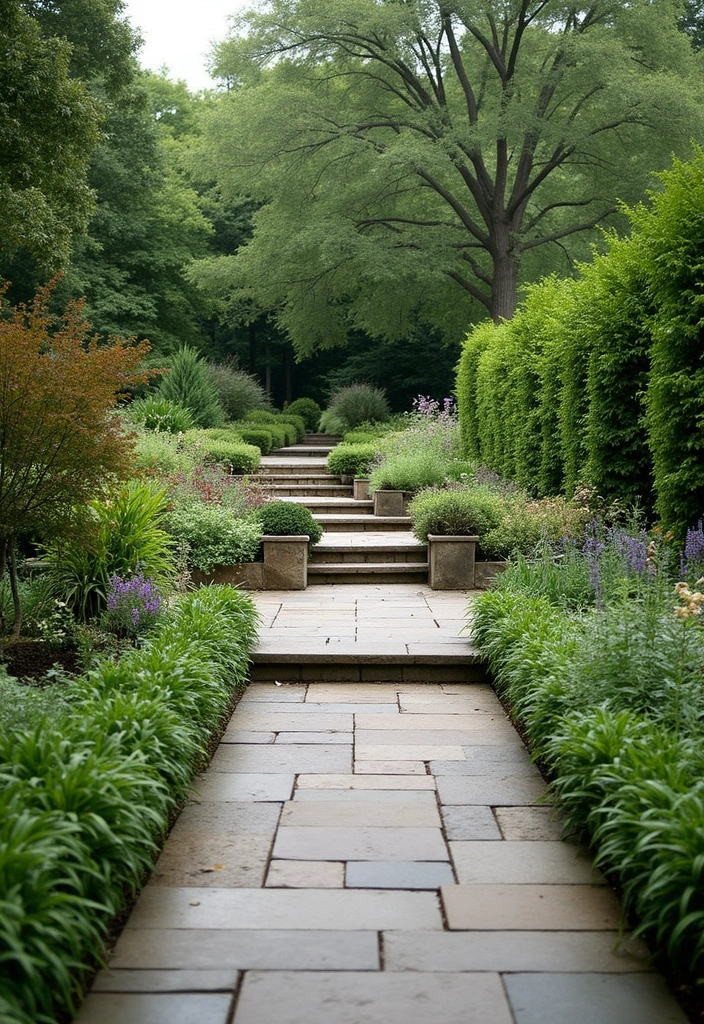
Incorporating various hardscape elements can add structure and depth to your formal garden. Paths, walls, and terraces can create interesting visual layers while providing usability, helping to define different areas of the garden and creating distinct spaces for various functions.
To elevate your garden’s design, consider using garden retaining wall blocks to create tiered planting areas for a dynamic look. These faux stone edging blocks not only enhance the visual appeal but also provide practical solutions for maintaining soil structure.
Incorporating an outdoor stone bench can also add height and a cozy spot to relax, enriching the overall experience of your outdoor space. This stylish seating option is perfect for enjoying the beauty of your garden.
Additionally, you might want to create terraces for visual interest and effective drainage. Utilize natural stone pavers to establish pathways and terraces that enhance the aesthetic while ensuring accessibility throughout your garden.
Hardscape elements not only enhance the overall design but also provide both functionality and aesthetic appeal, transforming your outdoor space into a captivating retreat.
Layering hardscape elements is the secret sauce to a stunning formal garden! From tiered terraces to cozy stone benches, each layer adds beauty and purpose, transforming your outdoor space into a captivating retreat.
24. Provide Garden Art
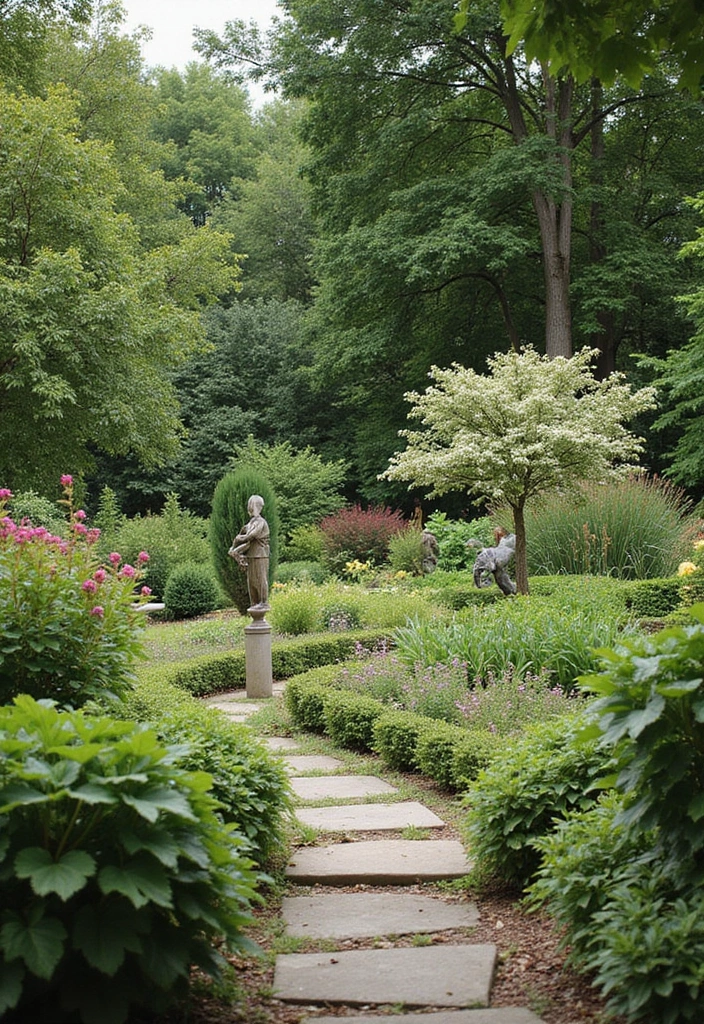
Garden art can serve as a wonderful way to reflect your personality and style within your formal garden. From whimsical sculptures to elegant ceramic pieces, art can add charm and uniqueness to the space. For instance, consider the Autodaya 36.75″ metal crane garden statue, an oversized blue heron that can create a dramatic focal point in your landscape. Its handcrafted design and stable U-ground stakes ensure that it will stand tall and confident amid your plantings.
On the other hand, if you prefer a subtler touch, the Danmu garden decor ceramic mushroom set offers a delightful way to add intimate moments of discovery. These random-color ceramic pieces are perfect for a fairy garden or as playful accents throughout your yard, with their charming 4.52″ height allowing them to nestle beautifully among flowers or shrubs.
For a whimsical touch, you might enjoy the Alpine Corporation 11″ tall outdoor metal wide-eyed bird. This colorful garden statue adds personality and a sense of joy, making it an excellent addition to any garden corner.
By thoughtfully integrating art into your garden, such as these suggested pieces, you create a personal touch that enhances the overall aesthetic of your formal garden, making it truly one-of-a-kind.
25. Maintain Simplicity
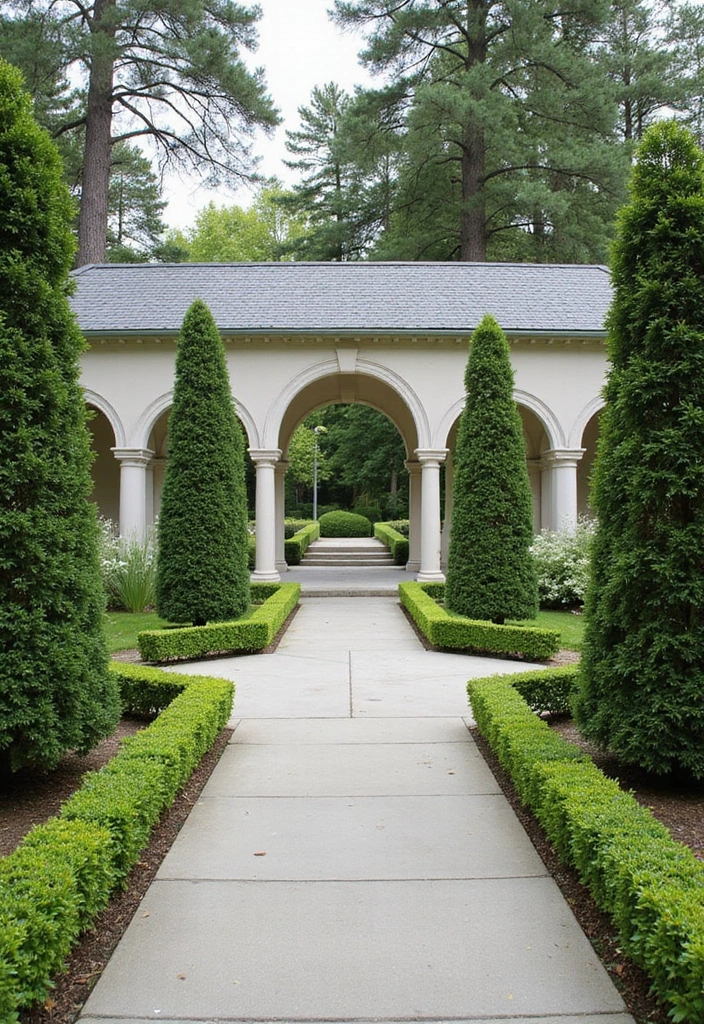
While complexity can be beautiful, maintaining simplicity in your formal garden design often yields the best results. An uncomplicated design can create a soothing environment that feels open and inviting. Focus on fewer elements, allowing each to shine on its own.
To achieve simplicity in your garden, consider selecting a limited palette of plants to avoid overwhelming variety. This approach not only makes it easier to design but also enhances the overall aesthetic. For those looking to expand their knowledge, the book Secret Teachings in the Art of Japanese Gardens: Design Principles, Aesthetic Values can provide inspiring insights and guidance on maintaining elegance in your garden.
When it comes to the physical elements of your garden, choose straightforward shapes and lines in your design. A great way to incorporate these designs is by using garden planter boxes like the VIVOSUN 3.6 x 1.3Ft Wooden Raised Garden Bed. These planter boxes not only add structure to your garden but also help in organizing your plant selections, allowing for a clean and uncomplicated look.
Additionally, prioritize open spaces between elements for a breathable feel. Proper tools can make all the difference in maintaining this simplicity. For practical gardening tasks, a reliable garden tools set such as the Fiskars House Plant Starter Tool Gift Set can equip you with everything you need, from pruning to planting.
Simplicity allows for elegance to shine through, making your garden a peaceful retreat in the outdoors.
Conclusion
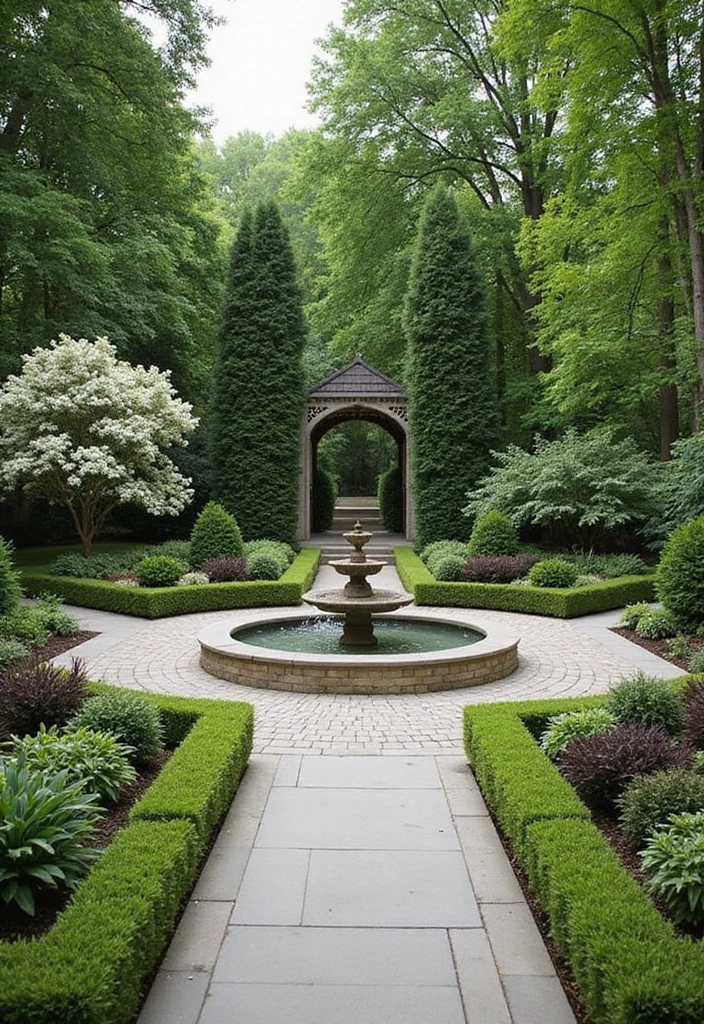
Crafting an elegant formal garden is a rewarding endeavor that harmonizes beauty with nature. By incorporating these 25 design principles, you can create an enchanting outdoor space that reflects your style and supports the environment. Dive into the journey of native plant landscaping and watch your garden blossom into a stunning retreat that everyone will admire.
Embrace these principles, and let your creativity flourish as you transform your outdoor space.
Note: We aim to provide accurate product links, but some may occasionally expire or become unavailable. If this happens, please search directly on Amazon for the product or a suitable alternative.
This post contains Amazon affiliate links, meaning I may earn a small commission if you purchase through my links, at no extra cost to you.
Frequently Asked Questions
What Are the Key Principles of Formal Garden Design?
The key principles of formal garden design include embracing symmetry, utilizing geometric shapes, and creating focal points to draw the eye. By focusing on these elements, you can craft a space that is both elegant and harmonious, ensuring your garden stands out beautifully.
How Can I Incorporate Native Plants into My Formal Garden Design?
Incorporating native plants is essential for an eco-friendly formal garden. Start by researching local native species that thrive in your climate. These plants are not only easier to maintain but also support local wildlife, enhancing biodiversity in your garden while maintaining that classic formal elegance.
What Are Some Effective Ways to Create Focal Points in a Formal Garden?
Creating focal points can elevate the beauty of your formal garden. Consider adding features like a striking sculpture, a serene water fountain, or a unique tree. By strategically placing these elements, you can create an enticing visual anchor that draws visitors’ attention and adds to the garden’s elegance.
How Do I Choose the Right Pathways for My Formal Garden?
Choosing the right pathways is vital for guiding visitors through your formal garden. Opt for materials that complement your garden’s overall design and ensure the paths are wide enough for comfortable walking. A well-planned pathway not only adds charm but also enhances the flow of your garden, making it an inviting space.
What Maintenance Tips Should I Keep in Mind for a Formal Garden?
Maintaining a formal garden requires planning! Choose low-maintenance plants that fit your climate and soil conditions. Regular pruning, weeding, and seasonal color changes can keep the garden looking fresh and elegant. Remember, simplicity in design often leads to less stress and more enjoyment of your beautiful outdoor space!
Related Topics

